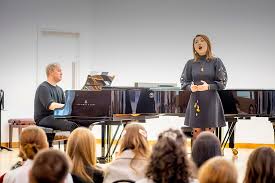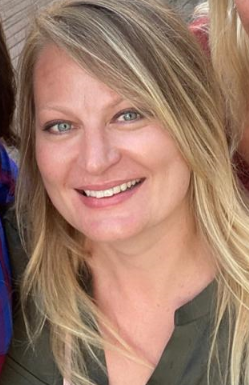
By
Sarah Hall and Gretta Sayers
April 2023
Print Version
What you need to know
In our collaboration as a singer and music theorist, we combine our interpretive perspectives on the mélodies (French Art Songs) of Belgian-English composer Poldowski (1879–1932). Recently, we shared our approach with students in a collaborative workshop with the aim of gauging its effectiveness in a pedagogical context. Our project integrates three threads: (1) incorporating research into undergraduate studies; (2) offering a pedagogical approach for post-tonal vocal music that explores intersections among musico-poetic phrasing, formal functions, and embodied learning; and (3) decentering the instructor as “knowledge gatekeeper” by empowering students to connect with their embodied experiences in performing.
Why this research is important
Music making engages both physical and intellectual practices. In our research, we use the language and tools of formal analysis to explore how they can facilitate an embodied, physical experience in performance.
Embodiment practices allow singers and pianists to engage with a song’s lyrics and meaning by applying the theoretical terminology while observing where the terms resonate energetically in the body. This process can bridge the gap between the intellectual and the physical aspects of music making. Our research provides a framework for musicians to process multiple layers of sensory language and information that can facilitate their understanding of the music’s structure as it is experienced in performance.
How this research was conducted
Our project involved three stages. First, vocalists learned two of Poldowski’s songs with a collaborative pianist. They journaled their method of learning the songs, independently and in collaboration with the pianist, to establish a baseline of their processes. Next, musicians participated in a seminar where they incorporated the analytical idea of formal functions into their performance and experimented with how their intellectual analysis and understanding of musical structure connected with their embodied performance. They explored their own engagement and observed and learned from their peers. In the final stage, they continued studying the songs by applying formal functions and completed their journals reflecting upon any benefits, challenges, and observations they experienced.
What the researchers found
The process can be used for learning post-tonal repertoire. Poldowski’s songs use non-functional tonality and Symbolist poetry. Elements of the music and the text are recognizable, but their order cannot always be readily predicted or anticipated. This combination can present challenges for students in their learning process. Applying the descriptive terms from formal functions can allow students to connect with the song’s musical structure and poetic meaning.
The approach offers students a method to explore the physical and intellectual aspects of music making towards an embodied practice. Formal functions (Arndt, 2018) can provide a framework for understanding musical structure by describing what the music is doing. Music can “establish” a beginning, create “confrontation” with a new theme, provide a “connection” between sections, or create “dissolution” by pulling apart previously “established” musical elements. Applying formal functions to Poldowski’s songs provided musicians with a method to link their analysis and understanding of the song’s lyrics and poetic meaning with the physical aspects of music creation. For example, when musicians can label a moment as “dissolution,” contextualizing a musically unstable moment as integral to the musical structure, it can facilitate a supported embodied experience for their performance.
Musicians in the study implemented the process to varying degrees. Students who find interoceptive practices helpful, i.e., practices that involve noticing and responding to internal sensory experiences, seemed to respond more readily to this process than students for whom those processes are less useful. Some fully embraced the formal function terms, while others preferred to create their own descriptive labels. Despite differences in the students’ responses, each found a way to connect with the process and embody their version of analysis and performance.
How this research can be used
This research offers practical intersections between performance and analysis in an undergraduate music program, areas that have traditionally been siloed. It nurtures a cross-genre perspective that develops students’ critical thinking, listening, and performance skills, further preparing them for advanced undergraduate or graduate work in music. While particularly useful for post-tonal music, the method can be applied to any musical genre.
Acknowledgements
Our gratitude goes to the students who participated in the project and shared their processes and experiences with us. This project was funded by the School of Music’s Mary Smart Development Fund and approved by BUREC.
About the Researchers
Keywords
- embodiment
- formal functions
- mélodies
- performance & analysis
- Poldowski
Editor: Christiane Ramsey
Read more BU Research
Research at Brandon University follows comprehensive policies designed to safeguard ethics, to ensure academic integrity, to protect human and animal welfare and to prevent conflicts of interest.


